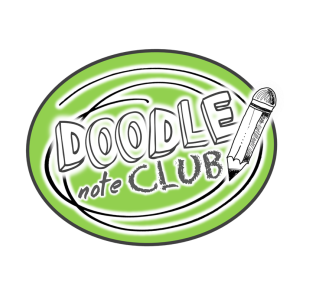4/17/2018
We are loving the many, many benefits of visual note-taking (retention, relaxation, focus, engagement learning, just to name a few… ), but here is one amazing benefit you may not have about yet! Doodle Notes are amazing tools for dyslexic learners. You’ve most likely had students who struggle with dyslexia in your class before, so I’ve rounded up some research on how Doodle Notes can help!

What is Dyslexia
You probably learned this at some point in one of your college courses, but here is a quick refresher. According to the Yale Center for Dyslexia & Creativity, dyslexia is defined as an unexpected difficulty in learning to read. Dyslexia takes away an individual’s ability to read quickly and automatically, and to retrieve spoken words easily, but it does not dampen their creativity and ingenuity.”
Students with dyslexia have difficulty matching the letter(s) they see on the page with the letter(s) sounds, which leads to trouble reading fluently.
Dyslexia Reading Patterns
When you think about it, reading is an extremely complex process. It involves connecting letters and sounds, forming words, then forming sentences, and then comprehending these sentences. So, understandably, if students with dyslexia have trouble with this first step of reading, it makes all of the other steps harder.
According to the Davis Dyslexia Center Association International, there is evidence from brain scans that students with dyslexia read better when implementing different strategies. Dyslexic adults who become capable readers use different neural pathways than those without dyslexia.
In their research studies, they found that those without dyslexia show a strong activation of the left hemisphere of the brain correlated with better reading skills; the opposite is true for people with dyslexia. For dyslexics, brain scans show better reading skills correlate with greater reliance on the right hemisphere.
Further studies, including brain imaging following children throughout school, researchers found some very interesting findings. These brain imaging studies show that teaching methods that may work well for a large majority of schoolchildren may be counterproductive when used with dyslexic children. “Teaching methods based on intensive or systematic drill in phonemic awareness or phonetic decoding strategies may actually be harmful to dyslexic children.”
Instead, children with dyslexia, may be better off with creative, meaning-based strategies. If you want to learn more about useful reading strategies, click here.

Image from https://pluslexia.com/
Dyslexia and Creativity
Although learners with dyslexia may read slower than others, this does not affect their intelligence. Oftentimes, people with dyslexia are very fast and creative thinkers. There is a lot of debate about whether this is an actual fact, or just a tendency. A study in France and Belgium found that there is definitely a correlation between dyslexia and creativity, but also concluded creativity is highly impacted by the educational approach.
To complement dyslexic students’ creative side, simply implement visual note taking by using doodle notes!
Engaging the Right Hemisphere with Doodle Notes
Having dyslexic students doodle while they learn allows them to engage with the right side of the brain, which then leads to more powerful connections with the material. Lecturing and taking notes the traditional way leads to less interaction with the material, because only their left hemisphere is being engaged.
Kelli Becton, at Adventure Homeschool, shares how doodling has immensely helped with teaching her dyslexic son! She explains how she knows doodling helps based on the facts, and also from her personal experience with her son; doodling very quickly made a world of difference!
Have you noticed a positive change in your dyslexic students’ learning with the implementation of doodle notes? If so, leave a comment here for everyone to see how Doodle Notes can truly make a difference!
